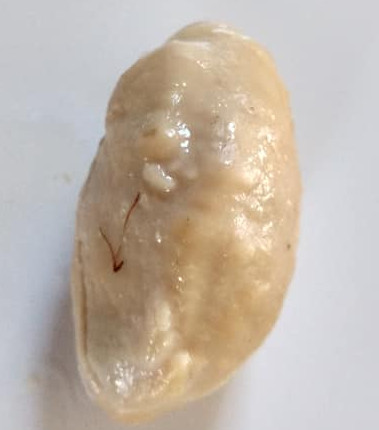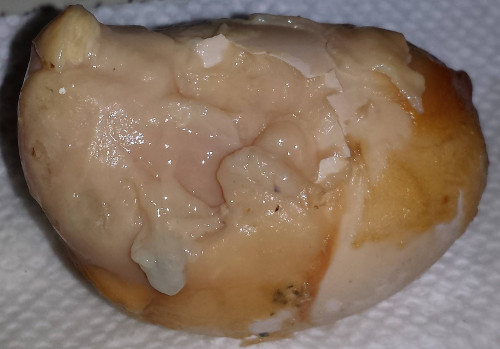Lash Eggs, Salpingitis or Egg Lash Disease in chickens

Salpingitis or Egg Lash Disease in chickens is the inflammation of the oviduct, is a serious reproductive related emergency frequently seen in hens specially bred for high productivity.
As a chicken keeper you should take special care with a lash egg and handle with disposable gloves and wash your hands afterwards. Humans are susceptible to most if not all of the bacterial causes of lash eggs.
What are lash eggs?
A lash egg is a coagulated mass of tissue sometimes containing or enclosed in a shell that is produced as a result of a chicken having an infected oviduct. Lash eggs may be a variety of shapes and sizes but are generally egg shaped and I have even seen one where the lash was part of a proper egg.
“Egg lash” defines “as an egg without a full-formed shell, covered only with a tough film or as a soft-shelled egg”.
Below: Lash eggs come in many shapes and sizes.

Lash eggs are the result of the infection of the oviduct being packaged up by an compromised egg producing organ and disposed off.
Lash eggs may contain:
- A waxy cheese like substance.
- Pus.
- Egg components.
- Tissue and membranes.
- Layers of material.
- Blood.
- A mind-bendingly bad smell.
What does a lash egg look like?
Lash eggs look to some extent like eggs, they may even have a shell or contain pieces of shell. They are mostly egg shaped although they may be elongated and have bumps and ridges along the surface.
Below: A lash egg.

Below: The same lash egg cut in half.

The inflammation in the oviduct may produce liquids or caseous exudate. "Caseous" mean resembling cheese or curd while "exudate" means a fluid contains a high content of protein and cellular debris which escaped from the blood vessel and has been deposited on the tissue surface.
Here are some more examples of Lash eggs.
Below: An Almost normal egg with lash attached.

Can you eat a lash egg?
No. You must never eat a lash egg. Humans are susceptible to most if not all of the bacterial causes of lash egg disease and you must take care handling the eggs and keep them away from children and pets as well.
Below: Dispose of lash eggs properly unless the vet has asked to see them and handle them carefully as they are infected material.

Prevalence of Salpingitis:
Multiple studies and discussion show that Salpingitis is one of most common cause of death in the poultry layers in the commercial poultry industry. Salpingitis is frequently found in backyard poultry, especially in older birds.
In young pullets, Salpingitis can bring about reduce egg production and is often due to Mycoplasma gallisepticum, Escherichia coli, Salmonella or Pasteurella multocida (fowl cholera) contamination.
It is a frequent lesion in female grills and ducks at processing. On gross assessment, Salpingitis might be hard to separate from the affected oviduct in adults. As the oviduct gets non-functional, the ovaries are generally decayed. Except if related to an infectious problem, this condition tends to be found irregularly during necropsy of cull hens.
What causes lash eggs or Salpingitis?
There are many causes of Salpingitis. It can be found in other species such as ducks and geese. It can be bacterial and viral origin, and the co-infection of Escherichia coli and tetra trichomonas (protozoa) can happen in ducks.
Salpingitis or lash egg disease results following the entry of the organism of the vagina (vent) and ascending the reproductive tact through reverse peristalsis, the infection can be descended from the greater abdominal air sac to the oviduct, by the blood in systemic disease, or spread from other adjacent tissue.
The masses in the oviduct will vary in size, the smaller masses within the oviduct up to the size of an egg can be passed by birds or can be regurgitated into the abdominal cavity by reverse peristalsis.
Below: A fairly normal shaped lash egg.

Masses can be so large that they can rarely cause rupture of the oviduct. Salpingitis can be septic or non-septic, where the non-septic structure is often a chronic condition. Salpingitis can also happen as a secondary complication to other conceptive related disease or a tumour. It can also lead to egg yolk peritonitis.
Can Salpingitis or lash eggs kill a chicken?
Yes. Salpingitis is a serious condition that can kill chickens within 24 hours if left untreated. It can leave a chicken unable to produce eggs or leave it infertile.
By the time you discover the chicken is ill it may have had a festering infection for weeks and the longer it has gone on, the less the chance of recovery.
Is Salpingitis or lash egg disease contagious?
To some minor extent, yes. Some of the causes of Salpingitis or lash egg disease are contagious. Viruses can spread easily between chickens, Protozoa can be spread in water and bacteria can infect other birds.
Salpingitis is an inflammation of the oviduct caused by an infection from E. coli, Salmonella, and such, I think it wouldn't be concerned about whether it is contagious.
Since chickens naturally carry a bacteria load in their bodies, they’re already at risk for the infection. If they get a laceration or some small tear in their oviduct or some other way for the bacteria to enter, it’s possible Salpingitis might develop.
So while it is possible it may be contagious under certain circumstances, this is probably not worth worry about that much.
There are two different types of lash egg disease, namely bacterial and viral:
Bacterial Salpingitis:
Salpingitis caused by bacteria tends to be more exudative, causing lash eggs that are large and firm contents of the masses to include exudate, yolk, eggshells, membranes, oviduct tissue, and malodorous oviduct secretions.
When these cheesy or caseous masses are cut into pieces they are onion layered texture or a progressive accumulation of a concentric layer of material. Sometimes fully formed eggs can be found in the caseous mass because of egg binding or because the egg becomes lodged in the oviduct in an area of localised inflammation.
It is caused by a wide number of infectious pathogens although Escherichia coli. Other, species involve include Mycoplasma, Actinobacteria, Pasturella, Salmonella, Corynebacterium, and Streptococcus.
Viral Salpingitis:
Viral Salpingitis lesions contain oedema, haemorrhage, and pale turbid, creamy, or gelatinous exudate. Viral causes are the most common infectious Bronchitis Virus, but can also include adenoviruses, New castle disease, and influenza viruses.
Some chickens are more at risk of lash eggs or Salpingitis than others. Predisposing factors are:
- Age over 2 years.
- Malnutrition.
- Over-nutrition.
- Obesity.
- Vent pecking - Bacteria enter the vent during pecking.
- Excessive abdominal fat.
- Excessive egg-laying.
- Prolonged egg-laying cycle.
- The intense egg laying and the associated oestrogen activity.
What are the signs and symptoms or Salpingitis or lash egg disease?
Hens with Salpingitis often present with non-specific signs which may be confused with many other disorders or diseases.
Clinical signs may include:
- Abdominal or malformed eggs-irregular shaped.
- Excessive thirst.
- Soft-shelled or blood streaked or lash eggs.
- On occasion, there may be cloacal discharge.
- Loss of appetite.
- Lethargy.
- Weight loss.
- Ruffled or fluffed feather.
- Damage vent leaking urates.
- Distended abdomen.
- Varying degrees of abdominal distension are usually present especially if there is an association with an impacted oviduct or cystic ovarian changes.
- Bird with penguin stance due to abdominal swelling.
- Abdominal firmness upon palpation.
- Laboured breathing.
- Decreased egg production.
- Eggs with abnormal shape.
- Wrinkles in the shell.
- Thin watery albumin in the egg.
- Sporadic death.
Diagnosis of lash eggs or Salpingitis is based on:
- Clinical signs.
- Production of lash eggs.
- Postmortem findings.
- Testing the bacteriology of the oviduct.
The postmortem on a chickens with Salpingitis or Lash eggs disease will show retained egg yolks, and a dilated oviducct filled with caseous exudaute.
Treatment of Salpingitis:
Antibiotics: If Salpingitis detects earlier while the pus relatively soft antibiotic like tetracycline may be used for bacterial Salpingitis. Antibacterial treatment varies depending on the bacteria and susceptibility of bacteria to antibacterial therapy. There is no treatment of Salpingitis of viral origin.
Surgery is an option, but you need experience avian veterinarian and willingness to remove the oviduct of chicken. This is very costly and always risks being considered when doing surgery.
Hormonal treatment like Suprelorin (deslorzin implants) to stop ovulation in hens.
An anti-inflammatory like Meloxicam can be used.
Euthanasia is also an option, depending on the severity of the disease in birds. The decision of euthanasia is based on the examination, symptoms, and quality of life.
Can you prevent lash eggs or Salpingitis?
Unfortunately, there's not much you can do to prevent your hens from laying lash eggs.
Regardless of whether your hens are healthy and eat an ideal diet, they can still develop Salpingitis. If you don't know which hens in your group are laying lash eggs, at that point, your best option is to observe your herd to check whether anybody looks "off" or sick. if every bird in the flock was healthy, if you think, your hens may have laid a lash egg, and you are worried, then your best option is to carry her to a certified vet.
Now, if you're pondering would you be able to eat a lash egg, then the appropriate answer is no. A lash egg is an accumulation of pus generally, and you certainly would prefer not to eat it. I would toss it in the refuse or clutch it if you need to take your hen to the vet.
Prevention of Salpingitis is by good flock management like:
- Reduce flock stress factors likely to result in vent pecking.
- Good chicken keeping bio-security measures.
- Properly balanced and nutritious feed.
- Free range to help avoid obesity.
- Vaccinate your chickens against the common causes of lash eggs like Bronchitis and infectious laryngotracheitis.
- Buy from NPIP suppliers.
If a bird dies you should do a necropsy to determine the cause of death.
Is lash egg or Salpingitis painful?
Yes. It is a serious infection of vital internal organs that may well effect more than one system and there is likely to be large amounts of inflammation.
Chickens often stand motionless when in pain and this is one of the symptoms of eggs lash disease.
